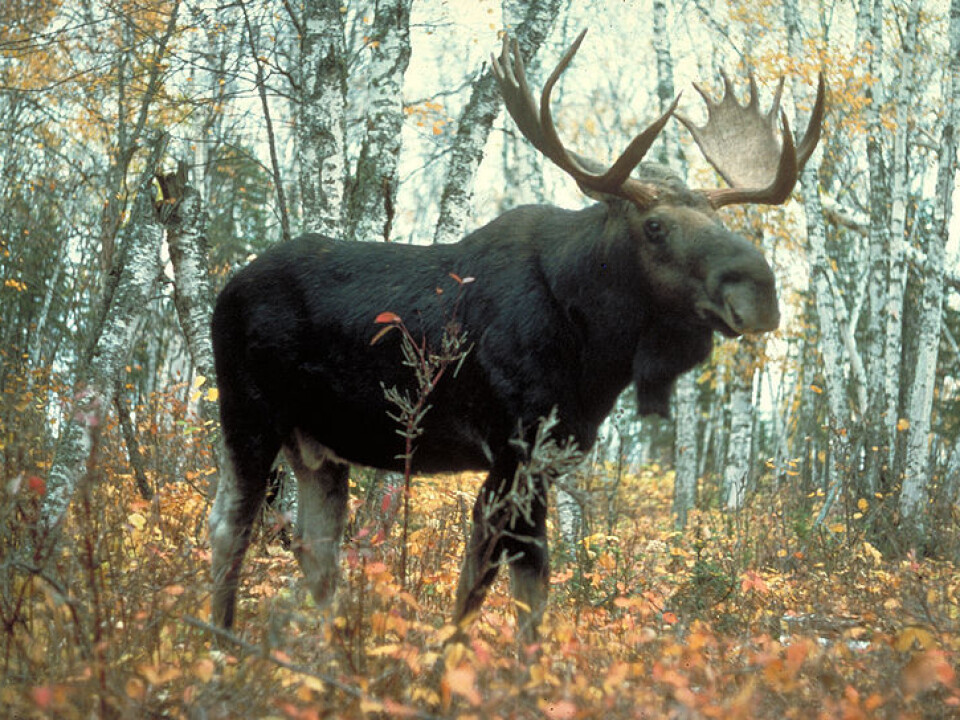
Norway’s oldest elk
A family in Norway has had the antlers of Norway’s oldest elk hanging on the wall of their home for over a century.
Denne artikkelen er over ti år gammel og kan inneholde utdatert informasjon.
When a farmer in the district Søndre Land was having a ditch dug in 1895 the farmhands made an interesting discovery:
They turned up a set of elk antlers with 13 points.
The farmer hung the antlers up in his house as a decoration and many years later, in 1912, the zoologist Robert Collett wrote about Norwegian mammals. Collett thought it must have been quite an old set of antlers.
But he couldn’t ascertain its exact age.

A recent study of the antlers reveals that the elk that bore them lived in the Norwegian wilds 10,300 years ago. This means it stems from Norway’s oldest elk [moose, to American readers].
Indicates an earlier immigration
Finn Audun Grøndahl, the curator at the Randsfjord Museums, was the first person in moderen times to realise that there could be something even more special about these antlers.
“I saw the description of the antlers in Collett’s book, and it turned out that the find had been preserved in good condition at the farm. It was easy to track down because they still hang on the wall there,” he explains.

“We carried out a Carbon-14 analysis, and the result showed the antlers were truly ancient: this is in fact the oldest land mammal we’ve found in Norway from pre-boreal era, in other words, from the end of the first millennium after last Ice Age.
The elk is a so-called pioneer species: it turned up in a region that had recently been covered by glacial ice. As the ice withdrew from the inland areas of Eastern Norway after the last Ice Age, this elk – and most certainly several others of its species – migrated from southern Sweden and inhabited what are now Norway’s Hedmark and Oppland Counties.
“The antler has pushed the date back for the known migration of land mammals in Norway after the Ice Age by several hundred years,” says Grøndahl.
A big bull
The antler has 13 points and is a very large specimen. The International Council for Game and Wildlife Conservation (CIC) now assigns points to elk, red deer and wild reindeer that are shot by hunters, based on the size and appearance of their antlers.
If this bull had been shot now, it would have been awarded 283 points, which would have earned the hunter a silver medal.
It’s impossible to estimate the size of the bull from its antlers, but it was most likely larger than today’s European elk.
“Skeletons of elk from the last stage of the Ice Age and the first stage of the post-Ice Age from southern Sweden and Denmark show that elk were larger than now. We see the same tendency for instance among brown bears – they too were bigger during this period,” explains Grøndahl.
In a colder climate being large has its advantages, it is easier to maintain body heat. As the climate warmed up after the Ice Age, it seems likely that the elk “shrank”, thinks Jørgen Rosvold, who holds a doctoral scholarship at NTNU Museum of Natural History and Archaeology in Trondheim.
“In addition mammals at that time could have had better access to nutrients, which allowed them to grow larger, or they could have even changed genetically,” he says.
Chance preservation
Very little natural historical material has been found from the pre-boreal period in Norway so any find is very valuable. The preservation of this pair of antlers is due to chance.
“Eastern Norway is generally a poor place for the preservation of buried bones, because the soil is quite acidic and it dissolves skeletons and the like. Here the antlers happened to end up in a micro-environment that preserved them,” explains Rosvold.
The researchers who have published a study of the elk in the periodical Fauna Norvegica, haven’t investigated the place where it was found and have written that its exact whereabouts are unknown today, 116 years after the antlers were uncovered. Grøndahl has a theory about how they could have been preserved:
“What probably happened here was that an elk was grazing for instance on the edge of little iced-over pond or bog when it shed its antlers. They have then fallen down to the bottom of the pond or bog when the ice thawed, where they were tightly sealed by sludge and kept well preserved,” he says.
Rare find
“This is one of the few finds we have from this time where we can clearly identify the species. There is no doubt that this was an elk,” says Grøndahl.
Most of the finds of animal remains from this period are from nomadic settlements, where the remains from the meals of our ancestors have been preserved with the remnants of the settlement.
“When humans leave discarded bones it is often tricky determining the species, because they are usually burnt. Virgin finds in the soil without a cultural context like this one are much easier to identify,” he points out.
Still mounted on the wall at Søndre Land
The antlers of this elk still hang on the wall of the family in Søndre Land, and Grøndahl says they will continue to do so as long as the family wants. He has no doubts that other fascinating remains of animals might be lying around in homes all over Norway.
“It’s important to make it known that such finds could contain new, vital information. This discovery from an elk is fascinating, it is a small part of Norwegian fauna history, and it could be a long time before another find comes along that pushes our datings of mammals from right after the Ice Ages further back in time,” he says.
Grøndahl stresses that people don’t need to fear the state will confiscate their finds if they contact authorities.
“There is no law decreeing that natural history material older than a certain date is to be considered state property, as is the case with cultural historical objects, but not everyone knows that. My guess is that some people are reluctant to notify about new or older discoveries because they fear they’ll lose them,” he says.
Bring them on
Grøndahl says that preserving natural historical material in room temperature, for example, can decrease the chances of making DNA analyses. If important discoveries are kept too long in poor conditions, vital scientific knowledge will be lost.
“I know that this has happened for instance with finds of mammoths in Norway, where the remains were kept locally for a long time and disappeared. It’s a real shame when such discoveries are lost,” he says.
“The main thing is that we should be notified about prospective finds, so that we can conduct genetic and other investigations while there is still a chance. I would strongly urge anyone with material they think might be interesting for scientists to contact natural history museums around the country. They can have the find analyzed and the owner can also keep it if he or she wants to,” he says.
----------------------------
Read this article in Norwegian at forskning.no
Translated by: Glenn Ostling






























